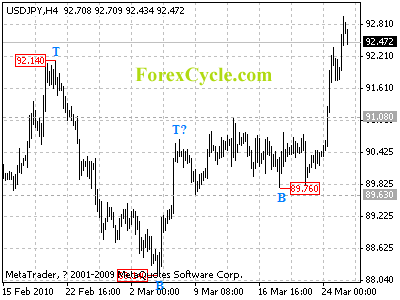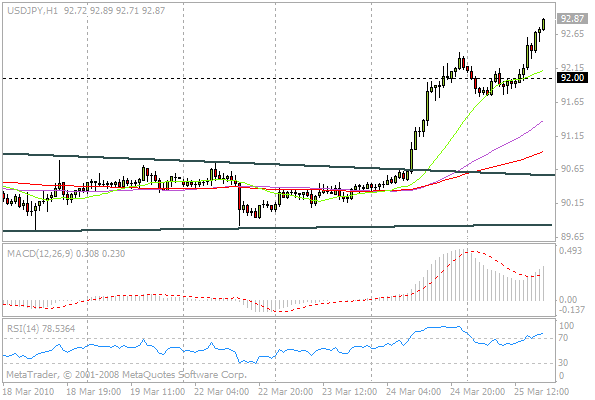Forex Market Review by Finexo.com
Past Events
• GBP Annual Budget Release
• USD Core Durable Goods Orders, out at 0.9% versus expected 0.6%, prior -0.6% (revised)
• USD New Home Sales, out at 308K versus expected 318K, prior 315K (revised)
• EUR German Ifo Business Climate, out at 98.1 versus expected 95.8, prior 95.2
Upcoming Events
• USD Unemployment Claims (1230 GMT)
• USD Fed Chairman Bernanke Testifies (1400 GMT)
• GBP Retail Sales m/m (0930 GMT)
• EUR Economic Summit, Day One
Market Commentary
In a highly political UK budget Chancellor of the Exchequer Alistair Darling has cut his growth forecast for next year to between 3% and 3.5%. He had earlier predicted growth would reach 3.75%. He stuck to his prediction the economy will expand by 1.5% this year.
The Chancellor also revealed that Britain’s budget deficit will be smaller than the £178bn expected in the pre-Budget report. The UK will borrow £167bn this financial year and £163bn next year. The central issue in the Budget has been the deficit, which standing at 12% of GDP is one of the largest in Europe. It has made the handling of the nation’s finances by Prime Minister Gordon Brown and Chancellor Darling a key election issue.
Uncertainty about the possible outcome of the General Election, due to be held on May 6th has weakened the Pound the international currency market. Polls have indicated that the Conservatives lead is narrowing, raising the risk of a hung  parliament. This would make any proposed spending cuts more difficult to implement. Yesterday’s budget postponed measures to curb the deficit until after the election is held.
parliament. This would make any proposed spending cuts more difficult to implement. Yesterday’s budget postponed measures to curb the deficit until after the election is held.
Investors reckon that only after the election the next Government – whether Labor, Conservative or a coalition – will spell out in detail the scale of the cuts in public spending and rises in tax required to return the public finances to health. Credit rating agencies have indicated they will wait until this time to judge whether Britain deserves to keep its much-prized ‘AAA’ rating, a measure of a borrower’s creditworthiness.
Out later today are UK retail sales figures. Last month figures were disappointing with a fall of 1.8% in sales volume. A rise of 0.6% is predicted this time.
The Pound dropped 0.81% against the US Dollar in trading yesterday to close at GBP 1.4896. It also dropped against the Euro by 0.22% to close at GBP 0.8945.
Across the Atlantic, US orders for durable goods rose in February for a third month, while inventories and backlogs climbed by the most in more than a year, indicating the manufacturing rebound will keep propelling the U.S. recovery.
The 0.5% increase in bookings for durable goods was in line with expectations and followed a 3.9% gain the prior month, the Commerce Department said today in Washington. Excluding transportation equipment orders rose 0.9%, more than anticipated.
Business spending on new equipment, inventory restocking and a pickup in global demand mean companies like Boeing can look forward to sustained sales gains. A pickup in employment is still needed to broaden the expansion as the economy heals from the worst recession since the 1930s.
“Manufacturing has and will continue to drive this recovery,” David Semmens, an economist at Standard Chartered Bank in New York, said before the report. “Export demand will continue to grow, domestic orders continue to rise and the inventory liquidation cycle has stopped dragging on growth.”
Elsewhere in the US, new home sales fell unexpectedly in February to a record low as blizzards, unemployment and foreclosures depressed the market. Purchases decreased 2.2 % to an annual pace of 308,000, according to figures from the Commerce Department. The average sales price climbed by the most in more than two years.
The new-home market is vying with foreclosure-induced declines in prices for existing homes in an economy where unemployment is forecast to average 9.6% this year, close to a 26-year high. Treasury Secretary Timothy F. Geithner said on Tuesday that it would take a “long time” to repair the housing market as the administration takes steps to overhaul real-estate financing and regulation.
The US Dollar gained 1.03% against the Euro yesterday, closing at EUR 1.3328.
Later today the unemployment claims for the past week are due to be published. A steady drop in unemployment figures has been seen since they touched 496K about a month ago. Another small drop is predicted this time, from 457K to 453K.
Also in the US today Federal Reserve chairman Ben Bernanke is due before the House Financial Services Committee for the second part of his testimony that will focus on the exit strategy for the economic stimulus package put in place after the global economic downturn. The testimony will take the form of a questions and answers session. The questions and the reactions are unknown, so this may easily lead to remarks that can move the markets, even if Bernanke doesn’t bring any real news.
In Europe German business confidence rose more than economists forecast in March as a weaker Euro boosted export prospects and warmer weather paved the way for a resumption of consumer spending and construction.
The Ifo institute in Munich said its business climate index, based on a survey of 7,000 executives, jumped to 98.1 from 95.2 in February, the highest reading since June 2008. Economists had expected a gain to 95.8. The index reached a 26-year low of 82.2 in March last year.
Greece’s fiscal crisis has contributed to the Euro’s 11% drop against the US Dollar in the past four months, making German exports more competitive outside the 16-nation bloc.
Today is the first day of a two day EU economic summit in Brussels. EU leaders are meeting to discuss ways the 16 nation bloc can recovery from slow economic growth and high unemployment and also how it should address the worsening fiscal crisis in Greece.
European Commission President Jose Manuel Barroso circulated a briefing paper ahead of the summit stressing the urgency of the tasks ahead.
“By taking bold action we can … avoid the trap of a decade of ‘sluggish’ growth and high unemployment, which would reduce our standard of living, put enormous strain on our social systems and diminish Europe’s role in the world,” he wrote.
A Greek rescue plan is not on the official summit agenda, but leaders will discuss the issue over lunch with European Central Bank President Jean-Claude Trichet. The meeting is expected to reach a political agreement on how to help Greece, while EU finance ministers will work out the financial details at a meeting Monday.
Forex Market Review & Analysis by Finexo.com
Disclaimer: Trading the foreign exchange (Forex) carries a high level of risk, and may not be suitable for all investors.







